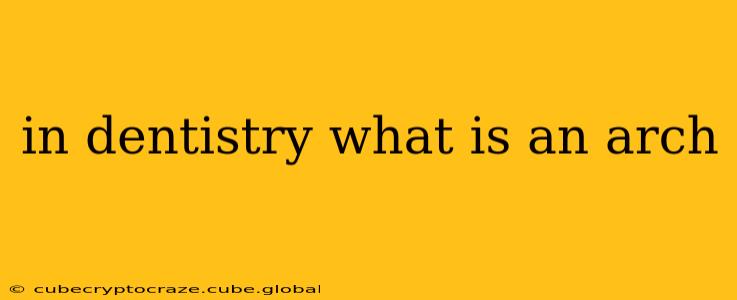In dentistry, an arch refers to the curved arrangement of teeth in either the upper or lower jaw. Think of it as a horseshoe-shaped row of teeth. We have two dental arches: the maxillary arch (upper arch) and the mandibular arch (lower arch). These arches are crucial for proper chewing, speech, and facial aesthetics. Understanding their structure and function is fundamental to dental health.
What are the maxillary and mandibular arches?
The maxillary arch, located in the upper jaw, is generally wider and more U-shaped than the mandibular arch. It's fixed to the skull, providing a stable base for the upper teeth. The mandibular arch, situated in the lower jaw, is more parabolic (V-shaped) and is mobile, allowing for the complex movements necessary for chewing and speech. Both arches work in concert to perform their vital functions.
What are the components of a dental arch?
Each arch consists of several key components:
- Teeth: The most obvious components, these are responsible for biting, chewing, and speech. The specific number and arrangement of teeth within each arch vary slightly between individuals, but the typical adult arch comprises incisors, canines, premolars, and molars.
- Alveolar bone: This is the bone that surrounds and supports the roots of the teeth. It's integral to the stability and health of the arch.
- Gingiva (gums): The gums surround the teeth and play a vital role in protecting the underlying alveolar bone and supporting the teeth.
- Periodontal ligaments: These ligaments connect the teeth to the alveolar bone, providing stability and shock absorption during chewing.
What are some common dental arch problems?
Several issues can affect the development and alignment of dental arches:
- Malocclusion: This is a general term encompassing any misalignment of the teeth or jaws. It can range from minor crowding to significant overbites or underbites.
- Crowding: When there isn't enough space in the arch for all the teeth to erupt properly, resulting in overlapping or crooked teeth.
- Spacing: The opposite of crowding, this refers to gaps between teeth within the arch.
- Crossbite: When the upper teeth sit inside the lower teeth, rather than outside them.
- Overjet: A significant protrusion of the upper teeth.
- Open bite: A gap between the upper and lower teeth when biting together.
How are dental arches treated?
Treatment for dental arch problems varies depending on the severity and type of issue. Common treatments include:
- Orthodontics: Braces or aligners are used to correct misalignments and improve the overall aesthetics and function of the arches.
- Extractions: In some cases, removing teeth might be necessary to create space for proper alignment.
- Orthodontic surgery: In more severe cases, surgical intervention might be required to adjust the jawbones.
What is the significance of dental arches in facial aesthetics?
The shape and alignment of the dental arches significantly impact facial aesthetics. A well-aligned arch contributes to a balanced and harmonious facial profile. Problems with the arches can lead to noticeable facial asymmetries or other aesthetic concerns.
How do dental arches affect chewing and speech?
Proper alignment of the dental arches is essential for efficient chewing and clear speech. Misaligned arches can make it difficult to chew food properly, leading to digestive problems. They can also affect speech articulation, making it harder to pronounce certain sounds.
This comprehensive overview provides a detailed understanding of dental arches, addressing common concerns and highlighting their importance for overall oral health and well-being. Remember to consult with a dentist for any concerns about the health or alignment of your arches.
